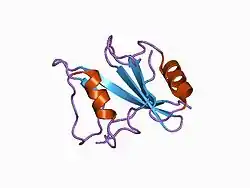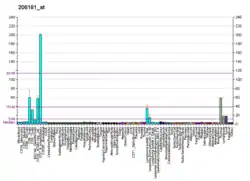Signaling lymphocytic activation molecule 1 is a protein that in humans is encoded by the SLAMF1 gene.[5][6] Recently SLAMF1 has also been designated CD150 (cluster of differentiation 150).
SLAMF1 belongs to the signaling lymphocytic activation molecule family. As other receptors from this family, SLAMF1 is expressed in different types of hematopoietic cells and it plays a role in the regulation of the immune system.[7]
Gene
The gene encoding SLAMF1 receptor is located on the human chromosome 1. It consists of eight exons and seven introns. Alternative splicing of SLAMF1 transcripts results in several isoforms of the protein, including the conventional transmembrane isoform (mCD150), secreted isoform (sCD150) cytoplasmic isoform (cCD150), and the novel transmembrane isoform (nCD150).[7]
SLAMF1 is expressed in hematopoietic stem cells. It is also used as one of the markers for their identification.[8] Furthermore, its expression was detected in thymocytes, NKT cells, T cells, B cells, monocytes, macrophages and dendritic cells. Monocytes, macrophages and dendritic cells express SLAMF1 after their activation. The activation of T cells and plasma cell differentiation leads to the increased expression of this receptor.[7][8] The interaction of SLAMF1 promoter and enhancers with the Early B-cell factor 1 (EBF1) is required for the expression of SLAMF1 gene in B cells. STAT6, IRF4, and NF-kB factors involved in the transfer of the signals from the B-cell receptor, its co-receptors and IL-4R, also play important role in the regulation of SLAMF1 expression.[9] The expression of SLAMF1 is not restricted to immune cells and their progenitors. From non-immune cells, platelets express SLAMF1.[7][8]
Structure
SLAMF1 is a type I transmembrane protein belonging to the immunoglobulin superfamily.[8] Its molecular weight is between 70 kDa and 95 kDa. The extracellular region of the receptor is composed of one Ig variable-like domain and one Ig constant 2-like domain. The intracellular region of the receptor contains two intracellular tyrosine-based switch motives (ITSMs) that interact with SH2 domain-containing proteins. However, nCD150 intracellular region differs from other isoforms of this protein, it lacks ITSMs. sCD150 isoform lacks the transmembrane domain and therefore, it can not be anchored to the cell membrane.[7]
Signaling
The receptor SLAMF1 mediates homophilic interactions as most of the receptors from the SLAMF. Signaling from SLAMF1 receptor can be activating or inhibitory. The type of the signal depends on the cell type, differentiation stage, and the combination of signals from other receptors.[7]
SH2 domain-containing proteins, specifically adaptor proteins SAP and EAT-2, and phosphatases SHP-1, SHP-2 and SHIP, interact with ITSMs in the intracellular region of SLAMF1.[7][10] Binding of SAP to ITSMs leads to the activation of the kinase Fyn that phosphorylates tyrosines of SLAMF1 and recruits downstream signaling proteins. Because of the high affinity of SAP to tyrosine phosphorylated ITSMs, it outcompetes the phosphatases which are the mediators of the inhibitory signal. Therefore, the expression and availability of SAP play a crucial role in the determination of the type of the signal.[11][12]
Function
SLAMF1 is involved in the regulation of thymocyte development, T cell proliferation, differentiation and T cell function, such as the cytotoxic activity of CD8+ T cells and the production of IL-4, IL-13 and IFNγ. In B cells, it regulates the proliferation and the antibody production.[7][8] SLAMF1 acts as a self-ligand during the interaction between B cells and T cells and promotes lymphocyte activation.[10]
The development of NKT cells is dependent on a signal mediated by SAP. It was found out that the homophilic interaction of SLAMF1 or SLAMF6 is required for SAP recruitment in NKT cells. This interaction mediates a secondary signal crucial for NKT cell differentiation and expansion in the thymus.[13]
SLAMF1 expression in macrophages is associated with killing of Gram-negative bacteria. SLAMF1 acts as a bacterial sensor. It is internalized after the recognition of Gram-negative bacteria, and it plays a role in the regulation of phagosome maturation, ROS and NO production. The absence of SLAMF1 in phagocytes leads, among other things, to the disruption of cytokine production.[13]
Role of SLAMF1 in diseases
Viral infections
SLAMF1 is a receptor for Morbilliviruses.[7] This genus of viruses includes agents causing measles in humans, rinderpest in cattle and distemper in dogs and cats.[14] Ig variable-like domain of SLAMF1 binds to hemagglutinin on the surface of the virus and this interaction mediates the virus entry into the host cell.[7]
Cancer
SLAMF1 is expressed in cancer cells in some types of hematologic malignancies (cutaneous T-cell lymphoma, few types of B-cell non-Hodgkin´s lymphoma, Hodgkin´s lymphoma and about 50 % of chronic lymphocytic leukemia cases).[7] It regulates cancer cell growth and survival by activating PI3K/Akt/mTOR signaling pathway. Therefore, SLAMF1 could be used as a diagnostical and prognostic marker in these cancer types.[8] Several cases of leukemia or Hodgkin´s lymphoma remission after measles virus infection or vaccination have been described. Therefore, SLAMF1 could be used as a target for cancer therapy which is based on the measles virus-mediated lysis of the cancer cells.[7]
nCD150 isoform was found in tumors of the central nervous system, such as glioblastoma, anaplastic and diffuse astrocytoma and ependymoma.[10]
References
- 1 2 3 GRCh38: Ensembl release 89: ENSG00000117090 - Ensembl, May 2017
- 1 2 3 GRCm38: Ensembl release 89: ENSMUSG00000015316 - Ensembl, May 2017
- ↑ "Human PubMed Reference:". National Center for Biotechnology Information, U.S. National Library of Medicine.
- ↑ "Mouse PubMed Reference:". National Center for Biotechnology Information, U.S. National Library of Medicine.
- ↑ Cocks BG, Chang CC, Carballido JM, Yssel H, de Vries JE, Aversa G (July 1995). "A novel receptor involved in T-cell activation". Nature. 376 (6537): 260–263. Bibcode:1995Natur.376..260C. doi:10.1038/376260a0. PMID 7617038. S2CID 4319295.
- ↑ "Entrez Gene: SLAMF1 signaling lymphocytic activation molecule family member 1".
- 1 2 3 4 5 6 7 8 9 10 11 12 Gordiienko I, Shlapatska L, Kovalevska L, Sidorenko SP (July 2019). "SLAMF1/CD150 in hematologic malignancies: Silent marker or active player?". Clinical Immunology. 204: 14–22. doi:10.1016/j.clim.2018.10.015. PMID 30616923. S2CID 58586790.
- 1 2 3 4 5 6 Farhangnia P, Ghomi SM, Mollazadehghomi S, Nickho H, Akbarpour M, Delbandi AA (2023-05-11). "SLAM-family receptors come of age as a potential molecular target in cancer immunotherapy". Frontiers in Immunology. 14: 1174138. doi:10.3389/fimmu.2023.1174138. PMC 10213746. PMID 37251372.
- ↑ Schwartz AM, Putlyaeva LV, Covich M, Klepikova AV, Akulich KA, Vorontsov IE, et al. (October 2016). "Early B-cell factor 1 (EBF1) is critical for transcriptional control of SLAMF1 gene in human B cells". Biochimica et Biophysica Acta (BBA) - Gene Regulatory Mechanisms. 1859 (10): 1259–1268. doi:10.1016/j.bbagrm.2016.07.004. PMID 27424222.
- 1 2 3 Fouquet G, Marcq I, Debuysscher V, Bayry J, Rabbind Singh A, Bengrine A, et al. (March 2018). "Signaling lymphocytic activation molecules Slam and cancers: friends or foes?". Oncotarget. 9 (22): 16248–16262. doi:10.18632/oncotarget.24575. PMC 5882332. PMID 29662641.
- ↑ Dragovich MA, Mor A (July 2018). "The SLAM family receptors: Potential therapeutic targets for inflammatory and autoimmune diseases". Autoimmunity Reviews. 17 (7): 674–682. doi:10.1016/j.autrev.2018.01.018. PMC 6508580. PMID 29729453.
- ↑ Wu N, Veillette A (February 2016). "SLAM family receptors in normal immunity and immune pathologies". Current Opinion in Immunology. 38: 45–51. doi:10.1016/j.coi.2015.11.003. PMID 26682762.
- 1 2 van Driel BJ, Liao G, Engel P, Terhorst C (2016-01-20). "Responses to Microbial Challenges by SLAMF Receptors". Frontiers in Immunology. 7: 4. doi:10.3389/fimmu.2016.00004. PMC 4718992. PMID 26834746.
- ↑ de Vries RD, Duprex WP, de Swart RL (February 2015). "Morbillivirus infections: an introduction". Viruses. 7 (2): 699–706. doi:10.3390/v7020699. PMC 4353911. PMID 25685949.
Further reading
- Punnonen J, Cocks BG, Carballido JM, Bennett B, Peterson D, Aversa G, de Vries JE (March 1997). "Soluble and membrane-bound forms of signaling lymphocytic activation molecule (SLAM) induce proliferation and Ig synthesis by activated human B lymphocytes". The Journal of Experimental Medicine. 185 (6): 993–1004. doi:10.1084/jem.185.6.993. PMC 2196230. PMID 9091591.
- Sayos J, Wu C, Morra M, Wang N, Zhang X, Allen D, et al. (October 1998). "The X-linked lymphoproliferative-disease gene product SAP regulates signals induced through the co-receptor SLAM". Nature. 395 (6701): 462–469. Bibcode:1998Natur.395..462S. doi:10.1038/26683. PMID 9774102. S2CID 4324402.
- Mikhalap SV, Shlapatska LM, Berdova AG, Law CL, Clark EA, Sidorenko SP (May 1999). "CDw150 associates with src-homology 2-containing inositol phosphatase and modulates CD95-mediated apoptosis". Journal of Immunology. 162 (10): 5719–5727. doi:10.4049/jimmunol.162.10.5719. PMID 10229804.
- Li SC, Gish G, Yang D, Coffey AJ, Forman-Kay JD, Ernberg I, et al. (December 1999). "Novel mode of ligand binding by the SH2 domain of the human XLP disease gene product SAP/SH2D1A". Current Biology. 9 (23): 1355–1362. doi:10.1016/S0960-9822(00)80080-9. PMID 10607564.
- Rogge L, Bianchi E, Biffi M, Bono E, Chang SY, Alexander H, et al. (May 2000). "Transcript imaging of the development of human T helper cells using oligonucleotide arrays". Nature Genetics. 25 (1): 96–101. doi:10.1038/75671. PMID 10802665. S2CID 5449948.
- Tatsuo H, Ono N, Tanaka K, Yanagi Y (August 2000). "SLAM (CDw150) is a cellular receptor for measles virus". Nature. 406 (6798): 893–897. Bibcode:2000Natur.406..893T. doi:10.1038/35022579. PMID 10972291. S2CID 4409405.
- Lewis J, Eiben LJ, Nelson DL, Cohen JI, Nichols KE, Ochs HD, et al. (July 2001). "Distinct interactions of the X-linked lymphoproliferative syndrome gene product SAP with cytoplasmic domains of members of the CD2 receptor family". Clinical Immunology. 100 (1): 15–23. doi:10.1006/clim.2001.5035. PMID 11414741.
- Kruse M, Meinl E, Henning G, Kuhnt C, Berchtold S, Berger T, et al. (August 2001). "Signaling lymphocytic activation molecule is expressed on mature CD83+ dendritic cells and is up-regulated by IL-1 beta". Journal of Immunology. 167 (4): 1989–1995. doi:10.4049/jimmunol.167.4.1989. PMID 11489980.
- Bleharski JR, Niazi KR, Sieling PA, Cheng G, Modlin RL (September 2001). "Signaling lymphocytic activation molecule is expressed on CD40 ligand-activated dendritic cells and directly augments production of inflammatory cytokines". Journal of Immunology. 167 (6): 3174–3181. doi:10.4049/jimmunol.167.6.3174. PMID 11544303.
- Murabayashi N, Kurita-Taniguchi M, Ayata M, Matsumoto M, Ogura H, Seya T (July 2002). "Susceptibility of human dendritic cells (DCs) to measles virus (MV) depends on their activation stages in conjunction with the level of CDw150: role of Toll stimulators in DC maturation and MV amplification". Microbes and Infection. 4 (8): 785–794. doi:10.1016/S1286-4579(02)01598-8. PMID 12270725.
- Li C, Iosef C, Jia CY, Han VK, Li SS (February 2003). "Dual functional roles for the X-linked lymphoproliferative syndrome gene product SAP/SH2D1A in signaling through the signaling lymphocyte activation molecule (SLAM) family of immune receptors". The Journal of Biological Chemistry. 278 (6): 3852–3859. doi:10.1074/jbc.M206649200. PMID 12458214.
- Hahm B, Arbour N, Naniche D, Homann D, Manchester M, Oldstone MB (March 2003). "Measles virus infects and suppresses proliferation of T lymphocytes from transgenic mice bearing human signaling lymphocytic activation molecule". Journal of Virology. 77 (6): 3505–3515. doi:10.1128/JVI.77.6.3505-3515.2003. PMC 149525. PMID 12610126.
- Del Valle JM, Engel P, Martín M (May 2003). "The cell surface expression of SAP-binding receptor CD229 is regulated via its interaction with clathrin-associated adaptor complex 2 (AP-2)". The Journal of Biological Chemistry. 278 (19): 17430–17437. doi:10.1074/jbc.M301569200. PMID 12621057.
- Ferrand V, Li C, Romeo G, Yin L (May 2003). "Absence of SLAM mutations in EBV-associated lymphoproliferative disease patients". Journal of Medical Virology. 70 (1): 131–136. doi:10.1002/jmv.10373. PMID 12629654. S2CID 44309832.
- Laaksonen K, Junikka M, Lahesmaa R, Terho EO, Savolainen J (December 2003). "In vitro allergen-induced mRNA expression of signaling lymphocytic activation molecule by PBMC of patients with allergic rhinitis is increased during specific pollen immunotherapy". The Journal of Allergy and Clinical Immunology. 112 (6): 1171–1177. doi:10.1016/j.jaci.2003.08.043. PMID 14657878.





